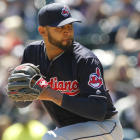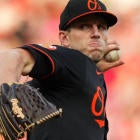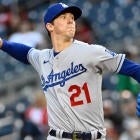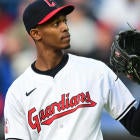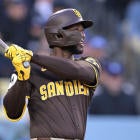Given the state of the pitching landscape these days, it's probably too much to ask to identify someone who can be a consistent difference maker moving forward. Between injuries and the widening of the gap between the haves and have-nots at the position, there aren't a lot of hidden gems out there.
If you've got one or more of the aces who has so far avoided the injury bug so far, congratulations! The rest of us have to make do with makeshift rotations, held together by duct tape and a wish, usually in the form of pitchers caught on the right wave. A good example from last season is Matt Shoemaker, who transformed himself into the league's preeminent expert on splitters, rode it to a sub-3.00 ERA over his final 20 starts.
You're just hoping to find someone who might not be an ace, but who can do a pretty good imitation for a while. At this point, that may be the best you can hope for in this pitching market. Here are five to target:
"How good is Danny Salazar, actually?" is a surprisingly contentious question in this office. He's one of those pitchers who can look like the best pitcher in baseball if you catch him on the right day. He has a swing-and-miss, mid-90's fastball, complemented by multiple swing-and-miss secondary pitchers, a repertoire that makes him capable of stretches as impressive as anyone's when he's on.
The problem is, Salazar will often look like he doesn't have a clue where his pitches are going, and most frustratingly, will switch between both sides of himself multiple times during the same start. And it's not just about control, as his command issues often result in him leaving the ball in hittable places, leading to five straight seasons of an HR/9 of at least 1.00.
Expecting a full season of dominance from Salazar is asking too much. However, Salazar has simplified his approach in the early going, largely forgoing his slider and curveball in favor of his changeup as his primary secondary, and has begun inducing swings on pitches outside of the strike zone more often this season. That could keep the walk rate low enough to limit the damage on those longballs. If anyone is capable of doing a reasonable imitation of an ace without the price tag, Salazar is the guy.
Velocity isn't everything, but there is an obvious, statistically significant relationship between fastball velocity and strikeout rate, so you can't just ignore it. Charlie Morton is a great example of that: When his fastball was averaging in the low-90's earlier in his career, he was a well below average strikeout pitcher; he has been above a 25 percent strikeout rate since adding 3 mph to his fastball over the last two seasons.
This kind of change shouldn't be ignored. It hasn't led to much more than a league-average ERA for Morton so far this season, but between good homer prevention skills, his heightened strikeout rate, and improved control, all of a sudden there is a lot to like about Morton. It might seem like smoke and mirrors for the 33-year-old, but you can't fake a 95 mph fastball, and there's reason to think Morton can be an actual contributor moving forward. Plus, he's still available in 20 percent of CBSSports.com leagues for free.
Fantasy players are rightly worried about Kenta Maeda, who has a 5.81 ERA after six starts. And that comes after a second-half slide in his rookie season and an offseason filled with questions about whether Maeda could successfully pitch every fifth day in the majors. The early returns seem to suggest the answer to that is a resounding "no."
However, the various defense-independent pitching stats show that Maeda hasn't been all that bad. Keeping the ball in the yard has been a real issue for him -- especially with runners on base -- but his 3.64 xFIP and 3.50 SIERA indicate there's at least some bad luck at play here. Maeda remains a strong strikeout pitcher, and his 15.2 percent swinging strike rate actually rates among the best in baseball, a sign that should be able to continue. A bit better execution with runners on base would go a long way to helping Maeda figure out his issues, and better luck might get him the rest of the way there.
Also, don't ignore the impact of who Maeda's catcher has been: In three starts with Yasmani Grandal behind the plate, he has a 3.18 ERA; in three pitching to Austin Barnes, that number is 9.00. That could be random, but given Grandal's reputation as one of the best pitch framers in the game, I'd like to see him back there for Maeda's next turn. And the one after that.
For someone with well over 1,000 career innings, Jeff Samardzija remains a remarkably difficult pitcher to pin down. At this point, it seems safe to assume he isn't the difference maker he looked like early on with the Cubs. Beyond that, he remains something of an enigma, sometimes posting elite strikeout rates, sometimes getting tons of groundballs. The only constant with Samardzija is, he's probably going to look like a very different pitcher every year, en route to 200 or so innings of work.
This season, Samardzija has ditched his cutter, replacing it with more fastballs, sliders, and splitters. The result has been an increase in his swinging strike rate, and an increase in strikeouts as well. The slider and splitter have long been better swing-and-miss pitches than the cutter was, and he never really seemed capable of generating the kind of weak contact he needed to with the cutter (career .193 ISO allowed with it) to justify the trade-off. Abandoning the pitch makes perfect sense.
It's not likely to be a cure-all -- just look at Samardzija's 5.03 ERA! -- but if you look beyond the surface, there are things to be positive about with Samardzija. At the very least, he could end up a must-start option at home, which has a ton of value in today's pitching market.
Jerad Eickhoff doesn't get the hype of some of his rotation mates, but between Vince Velasquez's inconsistency and Aaron Nola's injuries, it wouldn't be a big shock if he ended up the best of the bunch in the long run. However, if he's the best only by default, he won't be very valuable at all. I'm thinking he can be a bit more than that.
Eickhoff doesn't necessarily stand out in any one skill, but there's value in being average across the board. He strikes out about an average number of batters, walks about the same, and gives up a few more flyballs than average. Add it all up, and it's not a sexy combination, but he does a good job of limiting baserunners, limiting the impact of those flyball that go over the fence, and he has a pair of breaking balls he feels comfortable throwing for swings and misses. Eickhoff's stock is moving in the wrong direction after two subpar starts, but he's capable of long stretches with a mid-3.00's ERA, and might be available for a pittance. He doesn't have the upside of the other names on this list, but dependability has is its own virtue.























